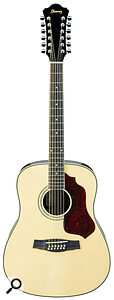I have someone coming into my studio to do some recording and I'm looking for a way to achieve a 12‑string guitar sound for him from a six‑string acoustic. I've looked for freeware plug‑ins but haven't had much luck.
Stephen Scott
Via email
 Generating the distinctive sound of a 12‑string guitar when you only have a six‑string might seem straightforward with the array of technology we have access to these days, but it's probably best done by rather more mechanical and low‑tech means.
Generating the distinctive sound of a 12‑string guitar when you only have a six‑string might seem straightforward with the array of technology we have access to these days, but it's probably best done by rather more mechanical and low‑tech means.
SOS Editor In Chief Paul White replies: There's no ideal way to do this, as even the best octave doublers double all the string pitches, whereas on a 12‑string guitar, the top two strings are tuned in unison. Should you wish to experiment with octave doublers, be aware that the vast majority of them are based on current pitch‑shift technology, which tends to sound a little warbly and thin on all but the most expensive processors. The reason for this is that pitch shifters work by breaking the sound into very short segments, then shortening them or looping them depending on whether the pitch shift is to be up or down. Where the pitch is to be increased by an octave, each audio segment is sped up to twice its normal speed, which makes it half its original length, so then it has to be used twice to fill the original time. This works OK on smooth sounds, but can give a doubling effect on the attack of notes. You can also hear an unnatural shimmering effect where the segments are rejoined.
More sophisticated pitch‑shifters try to minimise the damage to note attacks, but the most effective of these tend to be in software plug‑ins or designed to work on single‑note guitar lines. For all that, I've never managed to create a pitch‑doubling effect for guitar that sounds much like a 12‑string (other than with a Line 6 Variax or Roland VG system, where the strings are processed separately), and you'll often get a more realistic sound by just using the pitch‑shifter to add a slightly detuned version (detuned by somewhere between five and 10 cents) to the original. This produces a natural chorus‑like effect but doesn't replicate the effect of the octave strings — it sounds more like a 12‑string guitar where all the pairs are tuned to unison.
I think your best bet is to double the guitar part, with one pass played straight and one with an acoustic guitar restrung for Nashville tuning, where the bottom three strings (or four, if you prefer) are strung with thinner strings and tuned an octave above normal. If this isn't possible, try doubling the part with the second pass played using a capo, so that the chords sound in a higher position.
